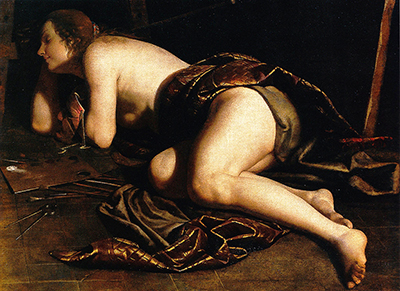Allegory of Painting was painted by Italian Baroque artist Artemisia Gentileschi. It was painted during her stay in England between 1638 and 1639. The self-portrait was owned by Charles 1 but was later recovered at the restoration in 1660.
This work of art is one of several pieces where Artemisia Gentileschi painted her self portrait. Other works where she represented herself include the Woman with Lute and Self-Portrait as a Female Martyr. In the Allegory of Painting, Artemisia depicts herself painting a different piece. She can be seen resting her left arm on a slab which she used to grind pigments. In the painting, she is dressed in a brown apron that covers a green dress. Hanging on her neck is a gold chain. The backgrounds of the painting is brown, and the canvas she used was black. This image was unavailable to any male artist because, by tradition, the art of painting was symbolised by an allegorical female figure. By the 18th century, her works had become so popular as she was among the few female artists who had managed to gain such a high status in society.
Allegory of Painting was completed in the oil on canvas method. This is a method of painting using pigments of colours dispersed in oil. It gained its popularity due to the many advantages it had. For example, canvas was a less expensive cotton fabric that was pulled across a wooden frame and tacked tightly at the back. It took time to dry, thus giving artists more time to make changes to the paintings.
His father, Orazio Gentileschi, heavily influenced Artemisia Gentileschi's style of painting. He taught her and his brothers how to paint in his workshop, but she showed more talent than the rest. Her art was natural compared to her father's, and this made her highly recognised and respected in her work. Caravaggio also inspired her by teaching her the use of contrasts of light and deep shade to produce an effect of intensifying emotion and the naturalistic depiction of human figures. Gentileschi managed to absorb his stylistic achievements while also developing her language.
Other famous paintings by Artemisia Gentileschi include Judith Slaying Holofernes, Susan, and the Elder, Self Portrait as a Lute Player, Judith and Her Maidservant and Self Portrait as a Saint Catherine of Alexandria. The Allegory of painting is currently housed in Kensington Palace since 1974.




